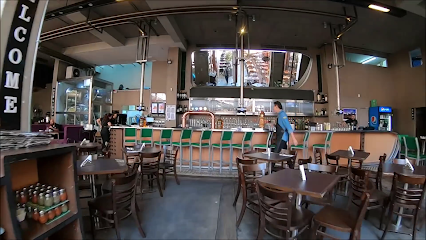
Exploring the Mystique of Easter Island's Iconic Moai Statues
Discover the ancient secrets of Easter Island through its iconic Moai statues, set against stunning landscapes and rich Polynesian culture.
Easter Island, known for its enigmatic Moai statues, offers a unique glimpse into ancient Polynesian culture. Tourists can explore these impressive monolithic figures scattered across the island, each telling a story of its own. With breathtaking landscapes and rich history, Easter Island is a must-visit for adventurers and history enthusiasts alike.
A brief summary to Easter Island Moai statue
- PA365-Parada 3, M) La Moneda, Santiago, Santiago Metropolitan Region, CL
Local tips
- Visit during sunrise or sunset for breathtaking views and fewer crowds.
- Consider hiring a local guide for deeper insights into the history and significance of the Moai.
- Wear comfortable shoes for exploring the rugged terrain around the statues.
- Bring water and snacks, as some sites are remote and lack facilities.
Getting There
-
Car
If you are renting a car on Easter Island, head towards Rano Raraku, the quarry of the Moai statues. From Hanga Roa, take the main road (Ruta 1) heading east. Continue for about 20 minutes until you reach the junction with the road leading to Rano Raraku. Follow the signs; the journey should take approximately 30 minutes. Be sure to stop and enjoy the views along the way.
-
Public Transportation
Use the local minibus service, known as ‘Colectivo’. From Hanga Roa, you can catch a Colectivo heading to Rano Raraku. The buses usually run every 30 minutes, and the ride will take about 40 minutes. Make sure to confirm with the driver that they are going to Rano Raraku before boarding. The fare is typically around 7,000 CLP (Chilean pesos).
-
Walking
If you're feeling adventurous and the weather is nice, you can walk from Hanga Roa to Rano Raraku. The hike will take about 3-4 hours. Head east on the main road (Ruta 1) and follow the signs. Be sure to wear comfortable shoes, bring water, and check the weather before you set out.
-
Guided Tour
Consider booking a guided tour, which often includes transportation from your hotel in Hanga Roa to Rano Raraku. Tours typically last half a day and provide insights into the history and significance of the Moai statues. Prices for guided tours usually start at around 25,000 CLP per person.
Discover more about Easter Island Moai statue
Iconic landmarks you can’t miss
Monument to General José de San Martín
0.1 km
Discover the Monument to General José de San Martín in Santiago, a historical landmark celebrating South America's journey to independence and cultural pride.

Monumento a los Héroes de la Concepción
0.3 km
Explore the Monumento a los Héroes de la Concepción, a symbol of bravery and a key historical landmark in Santiago, Chile.

Monumento a los Hermanos Amunátegui
0.5 km
Explore the Monumento a los Hermanos Amunátegui in Santiago, a striking historical landmark that celebrates Chile's rich cultural heritage and legacy.

Palacio Pereira
0.6 km
Discover the rich cultural heritage and architectural beauty of Palacio Pereira, an open-air museum in the heart of Santiago, Chile.

Barrio París Londres
0.7 km
Explore the historic streets of Barrio París Londres in Santiago, where architectural beauty meets vibrant culture in a captivating atmosphere.

Supreme Court of Justice of Chile
0.7 km
Explore the Supreme Court of Justice of Chile in Santiago, a stunning architectural gem and cornerstone of the nation's legal system, rich in history and significance.
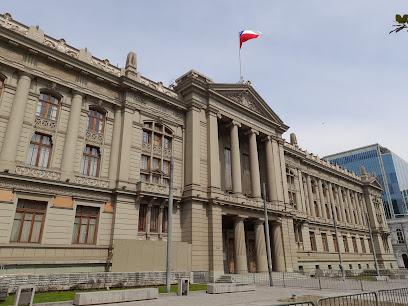
Palacio Larraín Zañartu
0.7 km
Step into history at Palacio Larraín Zañartu, a stunning architectural gem in Santiago, where heritage meets elegance.

Reliquias de Santa Rita de Cascia
0.8 km
Explore Reliquias de Santa Rita de Cascia, a serene historical landmark in Santiago, Chile, dedicated to the beloved Saint Rita and her miracles.

National Congress of Chile Palace in Santiago
0.8 km
Explore the National Congress of Chile Palace, a historical landmark that showcases the nation's architectural beauty and rich political heritage in Santiago.

Augustinians Convent and Provincial Curia
0.8 km
Explore the Augustinians Convent and Provincial Curia, a serene oasis in Santiago showcasing stunning architecture and rich spiritual history.

Christ of May
0.8 km
Discover the breathtaking Christ of May in Santiago, a historical landmark offering stunning views, cultural significance, and a serene atmosphere for all visitors.

Palacio de la Real Audiencia de Santiago
1.0 km
Discover the historical richness of Palacio de la Real Audiencia in Santiago, a stunning landmark of Chile's colonial past and architectural beauty.
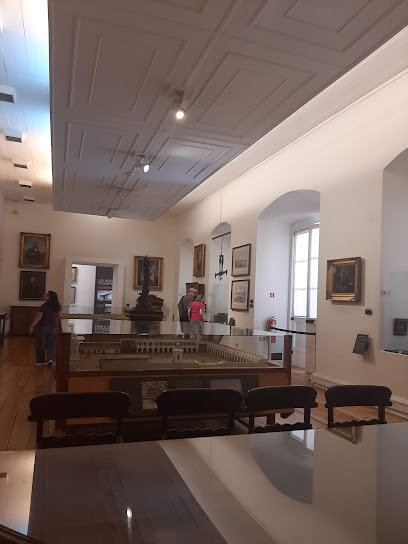
chiletourfun
1.1 km
Uncover the beauty and culture of Santiago with ChileTourFun, your gateway to unforgettable sightseeing adventures in Chile’s vibrant capital.
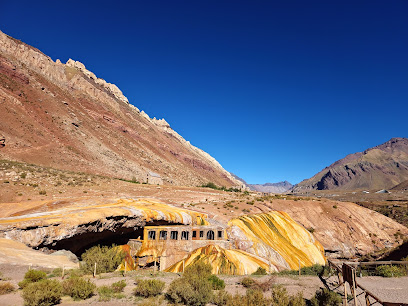
Maipo Wine Tours
1.3 km
Explore the stunning Maipo Valley with Maipo Wine Tours, your gateway to exquisite wines, breathtaking landscapes, and unforgettable outdoor adventures.

Pedro De Valdivia Letter
1.3 km
Discover the Pedro De Valdivia Letter in Santiago - a historic landmark that embodies Chile's rich cultural legacy and colonial history.

Unmissable attractions to see
Citizenship Park
0.2 km
Discover the tranquil beauty and cultural richness of Citizenship Park, a must-visit urban oasis in the heart of Santiago, Chile.
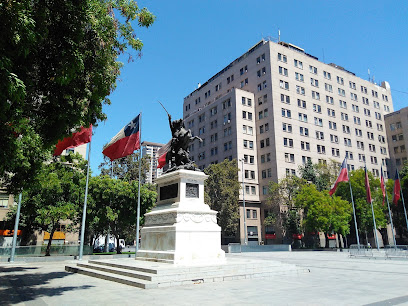
La Moneda Cultural Center
0.2 km
Experience the vibrant arts and culture of Santiago at La Moneda Cultural Center, a must-visit destination for every traveler.

La Moneda Palace
0.3 km
Explore La Moneda Palace, Santiago's iconic center of governance, rich in history, culture, and stunning neoclassical architecture.

Paseo Bulnes
0.3 km
Discover the beauty of nature in the heart of Santiago at Paseo Bulnes, an urban park full of vibrant life and local culture.

Monumento to President Salvador Allende
0.4 km
Explore the Monumento to President Salvador Allende, a significant memorial in Santiago celebrating Chile's rich political history and the legacy of social justice.
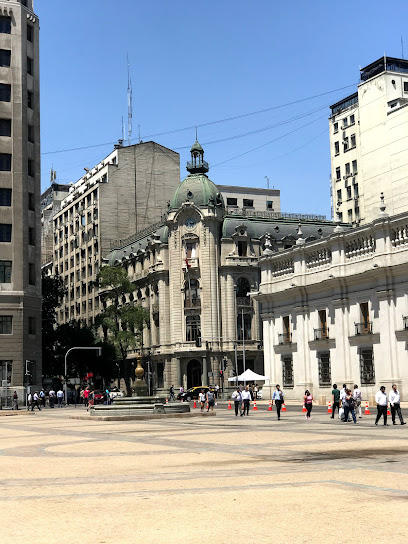
Constitution Place
0.4 km
Discover the vibrant heart of Santiago at Constitution Place, a lush park and plaza perfect for relaxation, culture, and social gatherings.

Sala Museo Gabriela Mistral
0.5 km
Unearth the legacy of Nobel laureate Gabriela Mistral at this charming museum in Santiago, celebrating her life and literary contributions.

Cine Club Sala Sazié - Cineteca Universidad De Chile
0.5 km
Experience the vibrant film culture of Santiago at Cine Club Sala Sazié, where cinema comes alive with curated screenings and engaging community events.

Edificio de la Bolsa
0.5 km
Explore the Edificio de la Bolsa in Santiago, a stunning historical landmark showcasing Chile's architectural elegance and rich financial history.

Archivo Central Andrés Bello
0.5 km
Explore the Archivo Central Andrés Bello in Santiago, a cultural haven for literature and history enthusiasts, showcasing Chile's rich intellectual heritage.

Librería y Editorial Universitaria
0.5 km
Explore the heart of Santiago at Librería y Editorial Universitaria, a treasure trove of Chilean literature and culture.

Church of the Augustinian Nuns
0.5 km
Explore the architectural and spiritual marvel of the Church of the Augustinian Nuns in Santiago, a serene retreat in the heart of the city.

Full Tour Chile
0.6 km
Explore Santiago's rich culture and breathtaking landscapes with Full Tour Chile's unforgettable sightseeing tours.

Paseo Bandera
0.6 km
Discover the heart of Santiago at Paseo Bandera, a lively cultural promenade filled with art, history, and local cuisine.

Palacio de La Alhambra
0.7 km
Explore the stunning Palacio de La Alhambra in Santiago, a heritage building that reflects the grandeur of historical architecture and cultural significance.

Essential places to dine
Confiteria Torres
0.2 km
Experience the rich flavors of Chile at Confiteria Torres, Santiago's historic restaurant offering traditional cuisine and delectable pastries.

La Chimenea
0.3 km
Experience authentic Chilean cuisine at La Chimenea in Santiago – where tradition meets modern flair for an unforgettable dining experience.

Blue Jar
0.3 km
Experience culinary excellence at Blue Jar in Santiago, where traditional flavors meet modern techniques for an unforgettable dining adventure.

Restaurant Bristol
0.7 km
Experience exquisite Chilean cuisine at Restaurant Bristol - a culinary gem nestled in the heart of Santiago.

El Naturista
0.8 km
Experience the best of vegetarian cuisine at El Naturista, where fresh ingredients meet vibrant flavors in the heart of Santiago.

Palacio del Vino
0.8 km
Discover the flavors of Chile at Palacio del Vino – where exceptional cuisine meets an extensive selection of local wines in Santiago.
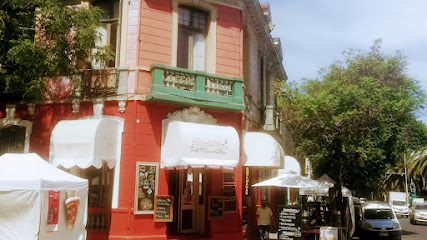
Los Vikingos Restaurant
1.2 km
Discover Santiago's culinary delight at Los Vikingos Restaurant - where premium steaks meet innovative dining experiences in Barrio Yungay.
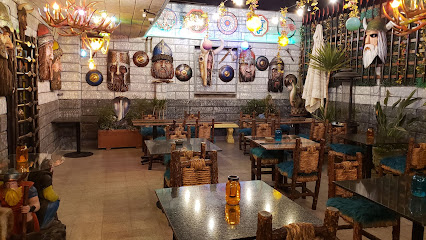
Na Que Ver, Cocineria Chilena
1.3 km
Experience authentic Chilean cuisine at Na Que Ver in Santiago's Barrio Yungay – where every meal tells a story.

La Piojera
1.3 km
Experience the vibrant flavors of Chile at La Piojera, Santiago's iconic bar and restaurant offering authentic cuisine in a lively setting.

Sky Sommelier Restaurante
1.4 km
Discover exquisite grilled cuisine and creative cocktails at Sky Sommelier Restaurante in Santiago - a must-visit culinary destination.

Quitral
1.4 km
Experience gourmet Chilean cuisine at Quitral in Santiago – where tradition meets innovation in every delicious bite.

Petit Bernard
1.5 km
Experience the best of Chilean cuisine at Petit Bernard in Santiago's vibrant Lastarria neighborhood.
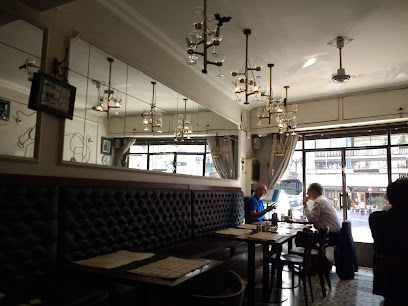
Chipe Libre - Républica Independiente del Pisco
1.5 km
Discover the vibrant flavors of Chile at Chipe Libre - Républica Independiente del Pisco, where tradition meets innovation in fine dining.

Bocanáriz
1.5 km
Discover the essence of Chile through exceptional wines and exquisite cuisine at Bocanáriz in Santiago's vibrant Lastarria neighborhood.

Holy Moly
1.6 km
Experience gourmet hamburgers in Santiago's vibrant Lastarria neighborhood at Holy Moly - where flavor meets fun!
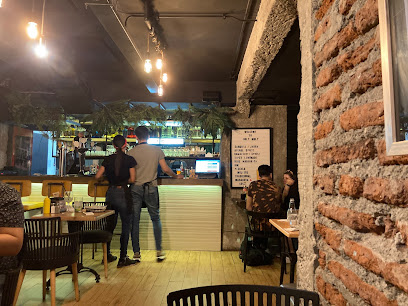
Markets, malls and hidden boutiques
Santiago Downtown G.
0.2 km
Explore Santiago Downtown G.: a bustling shopping mall in Santiago, offering trendy stores, delightful dining options, and a lively cultural atmosphere.

Multicentro Alonso Ovalle (Mall Chino)
0.6 km
Explore unique shopping and local culture at Multicentro Alonso Ovalle, Santiago's vibrant marketplace for treasures and flavors.

Alameda 949 - Nillkin Kyrios Local 27 A
0.6 km
Discover innovative cell phone accessories at Nillkin Kyrios, a vibrant store in Santiago offering expert advice and stylish products.

Galería Santiago Centro
0.6 km
Discover the vibrant Galería Santiago Centro, a shopping mall in Santiago that offers diverse shops, dining, and cultural experiences for every visitor.

Easter Island Chilean Fruits
0.8 km
Discover the vibrant flavors of Chile at Easter Island Chilean Fruits, your destination for fresh local produce and exotic fruits in Santiago.
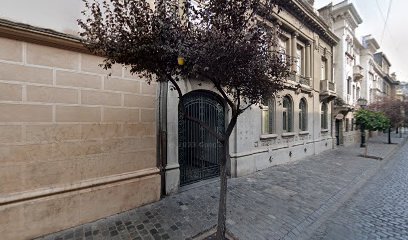
Mall Vivo Imperio
0.9 km
Discover a shopping paradise at Mall Vivo Imperio, Santiago's premier destination for fashion, dining, and entertainment.

Centro Artesanal Santa Lucia
1.1 km
Discover unique handcrafted treasures and experience the vibrant culture of Chile at Centro Artesanal Santa Lucia in Santiago.

Craft Fair Saint Lucia
1.1 km
Explore the Craft Fair Saint Lucia, a vibrant marketplace filled with unique handicrafts and local artistry that showcases the rich cultural heritage of Santiago.

Donde Golpea el Monito
1.2 km
Discover the vibrant world of hats at Donde Golpea el Monito, Santiago's charming hat shop brimming with style and culture.

SexShop Sexsexshop
1.4 km
Explore the vibrant adult entertainment choices at SexShop Sexsexshop in Santiago, where comfort and variety meet for an unforgettable shopping experience.

National Shop
1.5 km
Explore the vibrant National Shop in Santiago, a cultural haven for music, books, and film enthusiasts offering a unique local experience.

Recuerda Chile (Handicrafts / Souvenir Shop / Loja de Lembranças)
1.5 km
Explore Recuerda Chile for unique handicrafts and souvenirs that capture the vibrant spirit of Chile's culture and artistry.

Mercado la Vega
2.0 km
Experience the bustling Mercado la Vega, Santiago's fresh food market, where local flavors and vibrant culture come together for an unforgettable culinary journey.

Nuevo mall chino
2.1 km
Explore the vibrant Nuevo Mall Chino, Santiago's premier shopping destination offering a mix of local culture, dining, and exciting retail options.

Patio Bellavista
2.3 km
Discover the vibrant mix of shopping, dining, and culture at Patio Bellavista, a must-visit shopping mall in Santiago, Chile.

Essential bars & hidden hideouts
Goodrinks
0.9 km
Discover the vibrant nightlife at Goodrinks, a must-visit bar in Santiago offering a diverse drink selection and a welcoming atmosphere.

The Clinic Brasil
0.9 km
Immerse yourself in Santiago's nightlife at The Clinic Brasil, a vibrant bar offering unique cocktails and a lively atmosphere.

Matildas Hotel Boutique
1.0 km
Discover the charm and elegance of Matildas Hotel Boutique, your perfect retreat in Santiago's vibrant Barrio Brasil, blending luxury with local culture.

D'angelus
1.0 km
Discover D'angelus, a lively bar in Santiago offering exquisite drinks, local flavors, and a vibrant atmosphere perfect for unwinding after exploring the city.
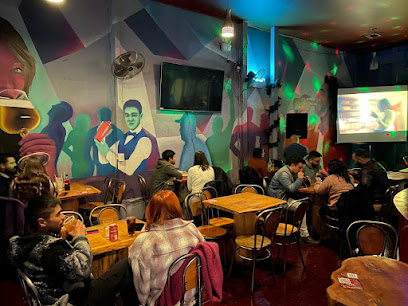
Club Callejón
1.1 km
Discover the vibrant nightlife of Santiago at Club Callejón, a bar and restaurant blending local flavors with an exciting atmosphere.

Saint George´s Gamer Bar
1.1 km
Experience the ultimate fusion of gaming and cuisine at Saint George's Gamer Bar in Santiago's vibrant Barrio Yungay.

St. Patrick's Day Irish Pub
1.2 km
Discover the heart of Ireland in Santiago at St. Patrick's Day Irish Pub, where great food, drinks, and live entertainment await.

Bohemia restobar
1.3 km
Discover the lively atmosphere and unique flavors at Bohemia Restobar, a must-visit bar in Santiago's artistic Barrio Brasil.
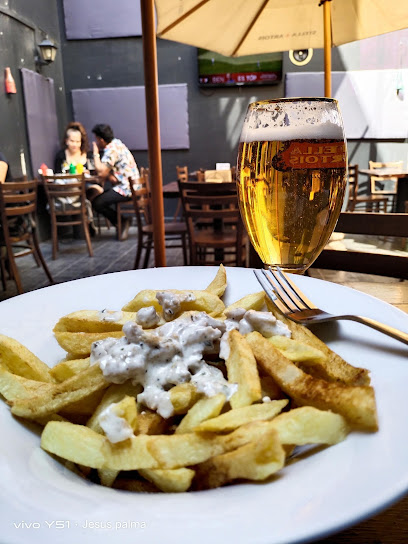
Stgo
1.3 km
Experience the vibrant nightlife of Santiago at Stgo, a lively bar offering a mix of local culture and exquisite drinks in an inviting atmosphere.

Donde Naresh - Exquisita comida del Sur de India
1.4 km
Explore the authentic flavors of Southern India at Donde Naresh, a top-rated Indian restaurant in Santiago, offering a vibrant culinary experience.

Bar Don Rodrigo
1.4 km
Experience the vibrant nightlife of Santiago at Bar Don Rodrigo, where excellent cocktails and a friendly atmosphere await.

Burdeos Santiago
1.4 km
Experience the vibrant culinary scene of Santiago at Burdeos, where delicious food and a lively atmosphere await you.

Red Pub
1.4 km
Experience the vibrant atmosphere and delicious grill specialties at Red Pub, a must-visit destination in Santiago for food lovers and social enthusiasts.

Barra Experimental
1.5 km
Discover the unique charm of Barra Experimental, Santiago's eclectic bar that combines craft cocktails with a trendy barber shop vibe.
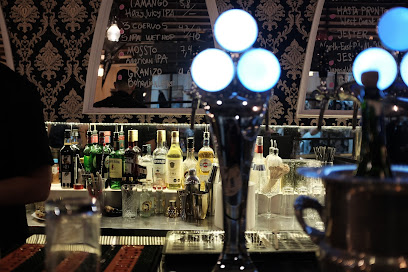
Bar La Junta
1.5 km
Experience the vibrant nightlife of Santiago at Bar La Junta, where innovative cocktails meet local culture in a lively atmosphere.
